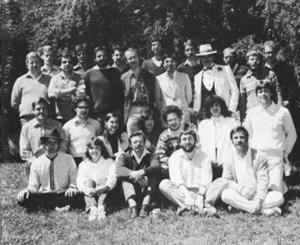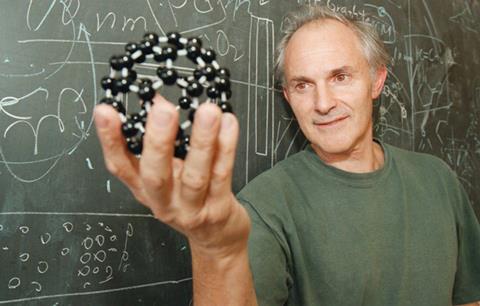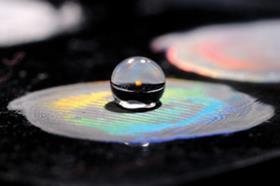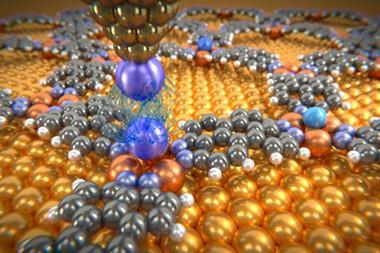Len Fisher gives a personal account of how colloid science evolved into nanoscience

Whatever happened to colloid science? Has it been totally supplanted by the young upstart known as nanoscience? Or is it still with us, lurking in the background, perhaps even preparing for a comeback?
Colloid science is concerned with the behaviour of assemblies of particles where at least one particle dimension lies between 1nm and 1µm. When I was a young scientist, some time back in the last millennium, it was an exciting field to be in. No longer was it ‘science in the slow lane’, to use a description coined by US physicist Evan Evans. The younger generation (including Evans) was taking over the field, introducing fresh ideas and making new and unexpected discoveries.
Many of the discoveries were concerned with calculating, measuring and controlling the forces between the particle surfaces. Most of the particles that we worked with had charged surfaces. One party trick was to take a suspension of negatively-charged monodisperse polystyrene latex spheres in a salt solution, and then use osmosis to gradually remove the salt. This increased the range of the repulsive forces between the particles until, at a salt concentration around 10–5M, the range became of the same order as the diameter of the particles (around 0.5µm). The tiny spheres were driven by their mutual repulsion to form an ordered array that would diffract light. This was not just scattering, such as that exhibited by the ruby-coloured gold sols that Michael Faraday made 150 years ago, and which are still to be seen in the Royal Institution today, but real, honest-to-goodness diffraction.
Faraday made his discovery accidentally while washing the residue from chemically treated gold leaf. He quickly came up with the correct explanation – that light was being scattered from tiny gold particles suspended in the water. But these latex suspensions were different – their manufacture was deliberate, and their properties had been predicted. I took a test tube full of the beautiful iridescent material to show off to my boss, Michael Tracey, chief of the Commonwealth Scientific and Industrial Research Organisation’s division of food research. He held it up to the light, inspected it from all angles, and then handed it back with the dry comment ‘Hmm. A phenomenon.’
That’s what the old colloid science was about – the phenomena that occur when myriad tiny particles get together in suspension. But nanoscience is concerned with the properties of the particles themselves, and particularly with size-dependent quantum mechanical properties, which can be very different for different materials. The common godfather of the two sciences is Albert Einstein, one of whose famous quartet of papers in 1905 concerned Brownian motion in particle suspensions, while a second was concerned with measuring the size of molecules and clusters of molecules, and a third helped to lay the foundations of quantum mechanics.
Magic and miracles
The transition from the old colloid science to the new nanoscience really began in the 1970s. Scientists in a number of laboratories (particularly in the UK, the US, the Netherlands and Australia) wanted to improve on the empirical methods that had been used up until then to calculate the short-range attractive van der Waals forces and longer-range repulsive double-layer forces whose balance determined the stability of many colloidal suspensions. Other forces could also be involved, including repulsive ‘steric’ forces between molecules coating the particle surfaces when these molecules came into proximity, while the role of solvent structure was scarcely understood at all.

Since I was involved mainly with the department of applied mathematics at the Australian National University (created and led by Barry Ninham), and since this cannot be a complete history, but simply a partly autobiographical contribution to the history that will someday be written, I will tell the story from that perspective, while recognising that there are many other important threads, and apologising to my many good friends in the community whose important contributions have not been mentioned.
Ninham had assembled a brilliant young team of theoreticians, and with Jay Mahanty had written the definitive textbook on calculating van der Waals forces properly. It was small but perfectly formed, so that no one need touch the problem again. He had also brought in the young Cambridge-trained experimentalist Jacob Israelachvili, who had developed his supervisor David Tabor’s idea of taking force measurement to nano-resolution by using two apposed, atomically smooth, crossed mica cylinders, one of which was mounted on a spring. This in turn was mounted on a drive that could be used to bring the surfaces closer together or take them further apart, the separation being controlled, and measured interferometrically, to atomic resolution.
The original measurements had been made in air in Cambridge. Now Israelachvili extended his technique to measure forces in liquids and to test theoretical predictions. With his new ‘surface forces apparatus’ (SFA), he could perform miracles, as visiting scientist Felix Franks admiringly exclaimed while watching Israelachvili and me working in the lab late one night.
One miracle was the detection of oscillatory ‘structural’ forces. These had been predicted by Ninham and John Mitchell on the basis that, at sufficiently small distances, continuum theory would break down and the structure and packing of the molecules would come to dominate. Could this, perhaps, be considered as the moment when ‘nanoscience’ was born? Certainly the discovery that some nanoparticles are particularly stable when they contain ‘magic’ numbers of atoms is, at the very least, a cousin to the original idea.
The first liquid in which oscillatory forces were detected was one with large, nearly spherical molecules. I had suggested cyclohexane, but Israelachvili and his postdoc Roger Horn used a bigger and better molecule – octamethylcyclotetrasiloxane. Israelachvili would go on to perform many other miracles with his apparatus, including the measurement of oscillatory forces in water (still not completely understood). In the meantime, I joined a team of Australian scientists to help produce a new textbook based on all of the exciting things that had been happening. It was called Foundations of colloid science, and was published in 1987. It was meant to be a foundation; it proved to be an epitaph.
Because the new kid on the block wanted more, in the form of intimate knowledge and control of the individual particles. And, partly by accident, the kid was now able to get it.
Look closely
The first ‘accident’ was the development of the scanning tunneling microscope (STM) by Gerd Binnig and Heinrich Rohrer at IBM’s laboratories in Zurich, Switzerland, in 1981. According to Heinrich Hoerber (now professor of nanobiophysics at the University of Bristol), Rohrer brought Binnig from Frankfurt to Rüschlikon at the end of his PhD for two reasons: firstly because Binnig was good at football, which they had played together in Frankfurt, and secondly because the solid state devices that IBM was trying to develop often failed through problems with surface impurities, and Rohrer wanted to look with Binnig for a tool to analyse these impurities at atomic resolution.

A sharp tip and a flat surface were obviously key and, with the help of very good Swiss technicians, the pair worked out how to make atomically sharp tips and mount them on a piezoelectric crystal to move them across a surface in raster fashion. The tip could be moved and held to within Ôngstroms of the surface using a second piezoelectric crystal and, with both tip and substrate being made of conducting materials, a tunnelling current could be generated by applying a voltage between the two. With the height being adjusted as the raster progressed to keep the tunnelling current, and hence the separation between tip and surface, constant, the contours of the surface could be measured to atomic resolution.

The new tool was soon being used to examine all sorts of conducting materials, both in crystal and particulate form. One of those materials was a new form of carbon, comprising 60 atoms in a ball, and discovered serendipitously by Harry Kroto and his colleagues during an experiment designed to mimic conditions in the interior of stars. The discovery of buckminsterfullerene, together with the development of a new method to look at the shape and properties of such small objects, stimulated huge interest. There was just one problem. The new method could only be applied to conducting materials.
All of that changed in 1986, when Calvin Quate invited Binnig to Stanford University in the US for a sabbatical. Their aim was to try to extend STM to non-conducting surfaces. Working with IBM’s Christoph Gerber, they settled down to try.
Getting a hard, sharp, non-conducting tip was relatively easy. Gerber, being from Basel, knew quite a bit about small, sharp diamonds, and these were the first tips of choice. But how could they measure the dominating short-range van der Waals forces between tip and substrate? The obvious approach was to mount the diamond tip on a soft spring. Then came the question of how to measure the deflection of the spring. Interferometry, such as Israelachvili had used, was not possible with opaque materials, but there was another possibility – to use a scanning tunnelling microscope on the other side of the spring! And so the first atomic force microscope (AFM) was born, the year before Binnig and Rohrer received the Nobel prize for physics for their earlier invention. STM was later used to manipulate particles as small as atoms on the substrate surface. When IBM discovered that a Nobel prize was in the offing, they flew Binnig and Rohrer to Zurich from a conference in Sicily – not to pose beside their apparatus, but to provide a photo opportunity of them playing football.
Form vs function
One stimulus for these three discoveries, and the possibilities that they offered, were primary catalysts for the transition of colloid to nanoscience. One marker of the transition was the gradual decline of the University of Bristol MSc course on colloids and surfaces, with up to 10 research council funded studentships per year in the 1980s, dwindling to zero in the early 1990s, followed by the development of the Bristol centre for functional nanomaterials, which now has 10 four-year studentships per year.
The key word here is ‘functional’, and part of the reason for the upsurge of interest in nanoparticles is that they can be used in so many innovative ways. Buckyballs themselves, along with their chemical derivatives, show promise for use in medical applications and as electron acceptors in solar cells. Microgel or core–shell particles may be useful for controlled uptake or release of drugs, while particles with chemically modified surfaces have obvious application in sensing.

Just a list of the potential electronic applications for nanoparticles would take more space than is available for this article. The term may be extended to include graphene, whose single sheet of carbon atoms shows promise in applications ranging from tissue engineering and bioimaging to Hall effect sensors, quantum dots, plasmonics and waterproof coatings (see Graphene beyond the hype). Rolled up into a carbon nanotube, it can become metallic or semiconducting (depending on the orientation of the lattice with respect to the tube direction), and used to make nanowires, field effect transistors and a host of other electronic components.
Nanosheets can also now be made from other materials, such as titanates. In one recent unusual application, the charged sheets were aligned cofacially in a strong magnetic field, and then set within a hydrogel. The resultant material deforms easily under a shear force, but is strongly resistant to compression – just the properties needed for inserting the material into knees such as mine, where most of the natural cartilage has long since gone.
Applications such as those above involve aggregates of nanoparticles, where the overall properties of the assembly are just as important as those of the individual particles. One difference from the old colloid science, though, is that the properties of the individual particles may be tuned to drive the assembly process.
And so the wheel has turned full circle, with surface forces between nanoparticles driving many applications. In truth, the study of colloid science in general, and surface forces in particular, has never really disappeared. In the early days of AFM, Richard Pashley at the Australian National University made a link by mounting a colloidal silica particle on an AFM tip. Israelachvili and his group at the University of California, Santa Barbara, have also continued with the surface forces apparatus, studying electrochemical effects and a host more.
I once asked Israelachvili why he hadn’t gone down the STM route – and in fact, why he hadn’t got there first. He laughed, and said that in the late 1970s he had been giving a talk at Clarkson University in New York on the surface forces apparatus, and afterwards sat at dinner next to a Norwegian who said ‘Why don’t you do some tunneling work?’ ‘Because I don’t think it’s worth it,’ he answered.
He later discovered that the Norwegian was Ivar Giaever, winner of the 1973 Nobel prize in physics for his discovery of tunnelling in superconductors. But Israelachvili had a point, because STM and its offshoots may be useful at the nano-level, but are not so good for measuring the surface forces that control the structure and behaviour of assemblies of nanoparticles.
Such assemblies are important for many applications, and colloid science, once thought to be dead, is re-emerging like a phoenix from the ashes, addressing as it does the behaviour of aggregates in one, two and three dimensions where the whole is greater than the sum of its (nano)parts. Perhaps a better bird metaphor would be that of the road-runner, because colloid science, having drifted along for a while in the slow lane, is now firmly and distinctly racing along again in the fast lane.
Len Fisher is a science writer and broadcaster, and visiting research fellow in the school of physics, University of Bristol, UK












No comments yet